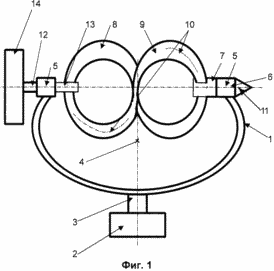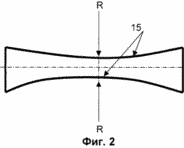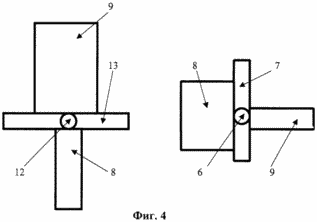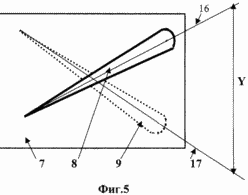| Start of section
Production, amateur Radio amateurs Aircraft model, rocket-model Useful, entertaining |
Stealth Master
Electronics Physics Technologies Inventions |
Secrets of the cosmos
Secrets of the Earth Secrets of the Ocean Tricks Map of section |
|
| Use of the site materials is allowed subject to the link (for websites - hyperlinks) | |||
Navigation: => |
Home / Patent catalog / Catalog section / Back / |
|
INVENTION
Patent of the Russian Federation RU2218476
![]()
WIND POWER PLANT
The inventor's name: Vladimir Petrovich Breusov; Elistratov Viktor Vasilievich
The name of the patent holder: Breusov Vladimir Petrovich ; Elistratov Viktor Vasilievich
Address for correspondence: 196600, St. Petersburg, Pushkin, ul.Zheleznodorozhnaya, 40, ap. 6, pat. To MVKozlov
Date of commencement of the patent: 2001.10.01
The invention relates to the field of wind energy and can be used in wind turbines with an axis of rotation that coincides with the direction of the wind. The technical result, consisting in increasing the efficiency of the installation, reducing its metal consumption and increasing the universality of use, is ensured by the fact that in a wind power plant containing wind-receiving working elements mounted on a horizontally located shaft that is both a generator shaft and mounted on a carrier, In the invention, the wind receiving organs consist of two symmetrically located identical blades, the middle lines of which have the form of a sinusoid, the horizontal axes of the latter coincide with the central horizontal axis of the installation, the vertical section of the blades is drop-shaped, with blunt ends directed towards the flow conditioner, and the blade In the form of a rectangle whose long sides are replaced by concave arcs with the same radii from the centers located on the central axis of the rectangle, the platforms on which the blade bases are mounted are rotated 90 ° relative to each other and the base axes of the blades installed on opposite sides Of one platform, form an acute angle between each other, while the sites through the bearing assemblies are mounted on a support arc that rests on another bearing assembly whose axis passes through the center of gravity of the installation.
DESCRIPTION OF THE INVENTION
The invention relates to the field of wind power and relates to engines with an axis of rotation that coincides with the direction of the wind.
A jet propeller with a vertical axis is known, comprising a rotor mounted on a support with vertical S-blades rigidly fixed between the end discs, the rotor having at least two S-blades installed in parallel. It is equipped with two rotors, mounted obliquely, with the blades of one rotor located at an angle of 90 ° with respect to the blades of the other (RF 2006664, F 03 D 03/00).
The disadvantages of this device include the following:
1. With this arrangement of the blades only 50% of the blade will work.
2. The device requires an additional device to drive the rotors downwind.
3. In this case, if one of the rotors is driven in the wind, then the other is outside the wind zone. Consequently, the low efficiency (EFFICIENCY).
4. Installation of metal and does not work in winds of low speeds.
A wind installation is known, consisting of a tower and shafts located on it, placed in a horizontal plane at an angle to each other and with wind wheels mounted on separate shafts, each shaft being articulated with its electric generator, and the wind wheels being made of double of an elastic endless belt, Divided in the specified sections by 180 ° and fixed on the cutters with a sloping plane (RF patent 2002104, F 03 D 01/06).
The disadvantages of this device include the following:
Installation works only on high support and at high wind speed. Complexity of construction and high metal content.
The closest analogue is a wind power unit containing a wind wheel mounted on a horizontal axis connected to the permanent magnets of the rotor that surrounds the circular stator with windings, a rotatable bushing on which the axis of the wind wheel and the device directing to the wind are fixed on the opposite sides. In this case, the stator with the rotor is placed vertically on the support and coaxial with it, and above them is mounted a corner transmission from the rotor to the wind wheel. In addition, the unit contains brake pads and a retainer installed at the base of the support, covering the lower part of the rotor on the outer surface. The retainer is installed under the lower edge of the blade of the wind wheel. The wind-directing device is rotatable at the hub in the mobile communication (RF patent 2000466, F 03 D 01/00).
The negative aspects of the present invention are:
Complexity of design, therefore, low reliability. Large metal consumption, low efficiency of use of wind energy, high acoustic tension. The device is not capable of operating at low wind speeds.
The object of the invention is to increase the efficiency of a wind power plant with the possibility of it in weak winds from 2 m / s with a decrease in its metal consumption and an increase in the universality of use.
The task is achieved due to the fact that in a wind power plant containing wind-receiving working elements mounted on a horizontal shaft, which is also the rotor shaft of the generator, the wind-receiving working elements located on the bearing element consist of two symmetrical and identical blades, the middle section of which has the form of a sinusoid , And their horizontal axes coincide with the central horizontal axis of the installation, while the vertical section of the blades has a drop-shaped shape, the blunt ends of which are directed towards the formation of the wind flow, and the sweeps of the blades are made in the form of a rectangle whose long sides are replaced by concave arcs of the same radius from both Directions and with the centers located on the central axis of the rectangle, the platforms on which the blades are mounted are rotated 90 ° relative to each other, and the central axes of the bases of the blades installed from the opposite sides of one site form an acute angle between them. The platforms themselves, through the bearing assembly, are mounted on a supporting arc, which is supported by another bearing assembly whose axis passes through the center of gravity of the wind power plant.
The new essential features are:
1. Wind-receiving working organs consist of two symmetrical identical blades.
2. The middle lines of the blades have the form of a sinusoid, the horizontal axes of the blades coincide with the central horizontal axis of the apparatus.
3. The vertical section of the blades is drop-shaped.
4. The sweep of the blade is made in the form of a rectangle, the long sides of which are replaced by concave arcs with the same radii and with the centers located on the central axis of the rectangle.
5. The platforms on which the blade bases are mounted are rotated 90 ° relative to each other.
6. The central axis of the bases of the blades, installed from the opposite sides of one site, form an acute angle between them.
7. The sites through the bearing units are mounted on a supporting arch.
8. The arc is supported by a bearing assembly whose axis passes through the center of gravity of the wind power plant.
The listed new essential features in combination with the known ones allow to obtain a technical result in all cases to which the requested scope of legal protection applies.
The technical result.
The plant operates at an efficiency of 52 to 86 percent, which is achieved by the dual use of the wind flow and the decrease in the induced resistance of the blades due to their drop-shaped shape, using the resulting lifting force as the unloading bearing assemblies.
The design and interposition of the blades allows the use of wind currents from 2 m / s and does not require a pre-launch.
The operation of the plant does not depend on its location. For the continuity of the use of the wind flow, two symmetrical identical blades are installed, and their configuration makes it possible to reduce the acoustic intensity of the installation (40 dB (decibel) at 1400 rpm), since in any two equidistant vertical axes the resulting rotational moments are equal. This allows the installation to be operated in densely populated areas.
When the wind direction is changed, the installation is self-aligned in the optimal direction.
 |
 |
 |
 |
 |
|
The graphic material is as follows:
1 is a diagram of a wind power plant.
2 shows a sweep of the blade.
3 is a vertical section of the blade.
4 shows the relative position of the blade mounting areas.
FIG. 5 shows the projection of the base of the blades on the mounting pad. FIG.
The wind power plant consists of a support arc 1 that rests on a bearing assembly 2 whose central axis 3 passes through the center of gravity of the installation 4. On the supporting arc 1, a shaft 6 with a platform 7 for fixing the blades 8 and 9 is installed on both sides through the bearing assemblies 5, The middle line 10 and the flow conditioner 11 on one side and the shaft 12 with the blade mounting area 13 and the rotor of the generator 14 on the other side. The blades 8 and 9 are identical and symmetrical with respect to the horizontal central axis of the installation. The middle lines 10 of the blades 8 and 9 have the form of a sinusoid whose horizontal axes coincide with the central horizontal axis of the installation. The vertical section of the blades 8 and 9 has a drop-shaped shape, the blunt ends of which are directed towards the flow conditioner 11. The sweep of the blades 8 and 9 is made in the form of a rectangle whose long sides are replaced by concave arcs 15 of the same radius R with centers located on the central axis of the rectangle. The platforms 7 and 13, on which the bases of the blades 8 and 9 are mounted, are rotated 90 ° relative to each other. The central axes 16 and 17 of the base of the blades 8 and 9, mounted on the opposite side of the platform 7, form an acute angle Y between themselves. The installation of the bases of the blades 8 and 9 on the platform 13 is similar.
The wind power plant works as follows. The wind flow runs on the flow conditioner 1l, which directs it to the blades 8 and 9. When the air flow of the blades 8 and 9, the cross section of which has a drop-shaped shape, zones of increased and reduced pressures are created, resulting in the appearance of a rotational moment, rotation. The resulting rotational motion of the shaft 12 is converted into electrical energy in the generator 14. When the direction of the wind flow changes, the wind power plant without additional adaptations by means of the flow conditioner 11 and the shape of the blades is self-orienting towards the wind flow. When the wind flow of the blades passes, a lifting force occurs, which reduces the load on the bearing units of the installation.
CLAIM
A wind power plant comprising wind-receiving working elements mounted on a horizontally located shaft that is both a generator shaft and mounted on a carrier element, characterized in that the wind-receiving working elements consist of two symmetrically located identical blades whose mid-lines are sinusoidal, the horizontal axes of the latter Coincide with the central horizontal axis of the installation, the vertical section of the blades is drop-shaped, with blunt ends directed towards the flow conditioner, and the blade is designed as a rectangle whose long sides are replaced by concave arcs with the same radii from the centers located on the central axis of the rectangle , While the platforms on which the blade bases are mounted are rotated 90 ° relative to each other, and the base axes of the blades installed on opposite sides of one site form an acute angle between them, the platforms through the bearing assemblies being mounted on a support arc that rests on Another bearing assembly whose axis passes through the center of gravity of the wind power plant.
print version
Date of publication 30.01.2007gg




Comments
When commenting on, remember that the content and tone of your message can hurt the feelings of real people, show respect and tolerance to your interlocutors even if you do not share their opinion, your behavior in the conditions of freedom of expression and anonymity provided by the Internet, changes Not only virtual, but also the real world. All comments are hidden from the index, spam is controlled.